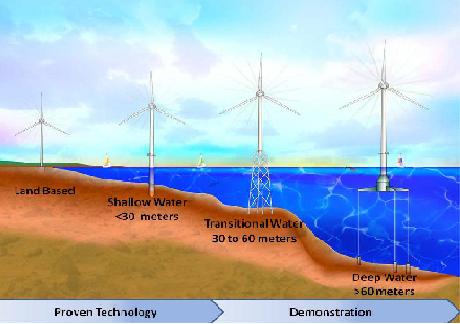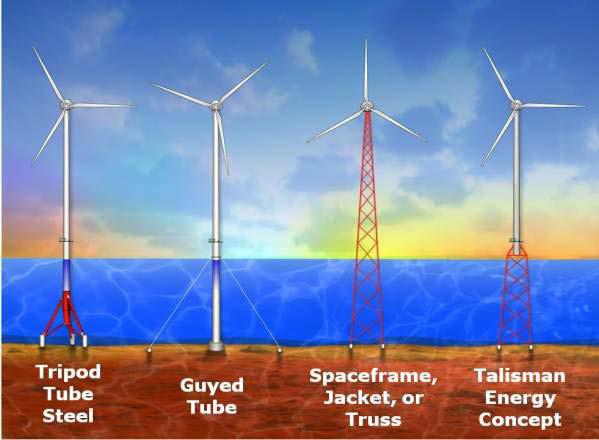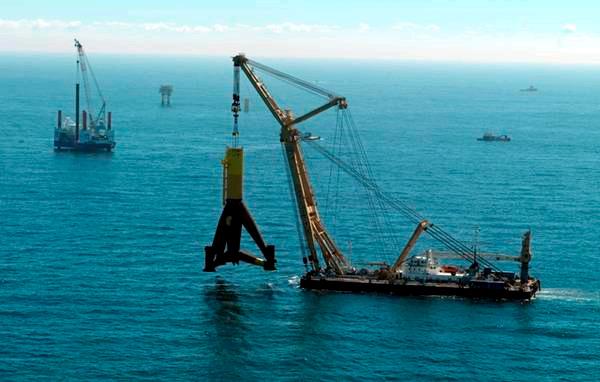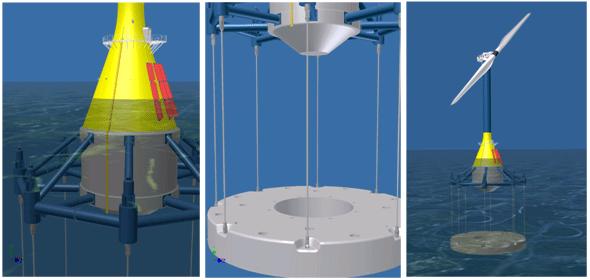Europe leads the way in offshore wind energy with over 800 turbines in operation, providing electricity to nine countries. The power generated by offshore wind farms in Europe increased by 51% in 2010, with current installed capacity of well over 3,000 megawatts. Seen as one of the most viable renewable energy sources, wind power is primed for rapid expansion in the coming years; a further 50,000MW is in planning or under development for 2011 onwards.
Offshore wind energy is still a fledgling industry in comparison to onshore wind power, and much of the technology in use today is borrowed from land based wind farms. The challenges and demands of the installation process are, however, markedly different to onshore installations due to the difficulties of operating at sea. The logistical complexity of these installations and the costs involved in terms of construction place heavy constraints on the industry; the design challenge is to make offshore wind farms an economical and viable source of power.
Construction, transportation and installation of foundations can cost up to three times as much as the installation of the turbines, so it forms a critical part of cost analysis. There are several design concepts in research and development and at testing stage that may answer the economic questions through engineering.
Design considerations
Downtime at sea is one of the biggest cost factors involved with offshore engineering. Construction time could be as much as doubled due to weather conditions, and as most equipment is hired, cost increase significantly. Installations are generally in two phases; the foundations are installed first, followed by the turbines. One potential way to tackle this problem is to construct as much as possible onshore, including the foundations, to limit build time at sea.
Design of foundations, particularly for deep water, is still in its infancy. The demands placed on turbine foundations vary greatly from those experienced in the offshore oil and gas industries. The technology and the knowledge of offshore installations for oil and gas can be utilized, but there are several differences that present technical and design issues. The design of wind turbine foundations must cater for dynamic response and fatigue under a working load over a long period, rather than the ultimate conditions. Generally, the vertical load is much smaller but the horizontal load is much greater. The design also needs to be considered in terms of multiple foundations as opposed to one large structure.
Deep water design

Source: NREL
The image above shows the generally accepted depths for offshore installations, which are split into three categories; shallow water, transitional water, and deep water. The vast majority of installations worldwide are in shallow water, with only a few test projects in operation at greater depths.
Deep water is by far the greatest resource of wind power, with greater wind speeds and the potential to install larger turbines. There is no agreed limit on turbine size, and a report from the UpWind Project found that rotor diameter will be up to 150m, and turbines will be 8-10MW in power in the near future. Several 10MW turbines are already in development with manufacturers across Europe.
The design challenge is to develop substructures or floating platforms to support high power turbines; moving away from the current designs borrowed from onshore wind farms, and incorporating technology from the oil and gas industries, while adapting it to the specific requirements of wind turbines.
Existing shallow water designs
The designs currently used in shallow water include monopiles and gravity base foundations, while a suction bucket concept is in the later stages of development.
Monopiles are used in the majority of offshore wind farms. The London Array project, which is currently under construction, is set to become the worlds largest offshore wind farm with 177 turbines producing 1000MW supported by monopiles. They are relatively simple by design and have a minimal impact on the seabed; but they are limited by resonance in deeper water. The frequency of the turbine decreases as water deepens. To maintain stiffness the diameter of the monopile must increase; eventually to the point where it far exceeds the necessary size for structural support. The greatest practical depth for a monopile is considered to be around 30 metres.
Gravity base foundations are an alternative and have been used on several sites, including the Thornton Bank project in Belgium. They require in depth seabed analysis as they are sensitive to soil conditions, but do provide an option where pile-driving is not viable. Suction buckets are not in commercial use as yet, but significant research has been carried out on them. They consist of a wide base that is driven into the seabed by drawing a vacuum and using hydrostatic pressure to seat the bucket. This technology offers an alternative to monopiles and the use of large pile-drivers.
Norwegian company Seatower introduced a crane-free gravity base foundation late in 2010 that is economically viable at depths of up to 50 metres. In an interview with WindEnergyUpdate CEO Petter Karal said, “The crane-free gravity is economical down to about 50 metres water depth. However, we have ways to build cost-efficiently down to as much as 100 metres based on crane-free technology.”
The foundations can be fully manufactured at quayside, before being towed out to sea using standard tugs. There is no need to use specialist vessels or cranes during installation, and the entire installation process takes just 12 hours, which means less downtime due to bad weather conditions. Although these foundations are not yet in use commercially the technology has been proven in the oil and gas fields, and as there is no seabed preparation required there is less impact on the environment and local eco-system.
This technology could provide an economically viable solution for deep water installations due to the low manufacturing and installation costs.
Transitional water concepts

Source: NREL
Transitional foundations are used, and are being developed for water depths between 30-60 metres. As water depth goes beyond 30 metres larger substructures with wider bases are required to cope with increased overturning forces, and to meet design specifications for stiffness. Some of the examples in the image above are not yet in operational use, and due to financial constraints surrounding installation, may not prove to be competitive with shallow water wind farms.
The guyed steel tube design has yet to be tested in the water, but offers a wide support base. The Spaceframe concept is derived from land based designs, although they were not used extensively onshore due to high costs.
The Talisman, or ‘jacket’, design was first used by Talisman energy in 2006 at the Beatrice Wind Farm Project; with two turbines installed on the lattice like structures at depths of 45 metres.
The design was also used, along with a tripod foundation (pictured below being lowered by crane) at the Alpha Ventus Project, north of the island of Borkum, Germany. Completed in 2009 the project incorporated six jacket type foundations alongside six tripod foundations. All twelve turbines are 5 megawatts, and it is the largest transitional wind farm in the world today.

Source: alpha-ventus.de
Deep water designs
Deep water foundation development is still at an early stage, but presents a number of potential advantages over shallower water wind farms. It is possible through floating foundation technology, that costs could be reduced through quayside manufacturing and mass production. Much higher winds for longer periods offer greater power resources, and the impact on the environment could be vastly reduced. Several different concepts are undergoing research and development, and the most prominent are explored below.
Blue H – Submerged Deepwater Platform (SDP)
Dutch company Blue H have developed a floating platform adapted from existing concepts of TLP design for oil and gas rigs. The SDP can be manufactured onshore and towed to site at depths of 60 metres or greater. The platform is buoyant and is held semi-submerged in the water by chains connected to a counterweight on the seabed. The uplift created by the hollow platform keeps the chains permanently tensioned. Blue H tested a prototype of the foundation, along with an 80 kilowatt wind turbine, off the coast of southern Italy in depths of 113 metres.

Source: bluehgroup.com
The final design concept in the image above is expected to be deployed in 2014, and combined with turbines that have a much higher power rating.
Editor’s note: This article was kindly provided by IQPC, which has offices in major cities across six continents including: Berlin, Dubai, London, New York, Sao Paulo, Singapore, Johannesburg, Sydney and Toronto. IQPC leverages a global research base of best practices to produce an unrivalled portfolio of problem-solving conferences. Each year IQPC offers approximately 2,000 worldwide conferences, seminars, and related learning programs. IQPC will be holding the Offshore Foundations for Wind Turbines conference in Bremen (Germany) from 4 to 6 July, 2011.
For additional information:

